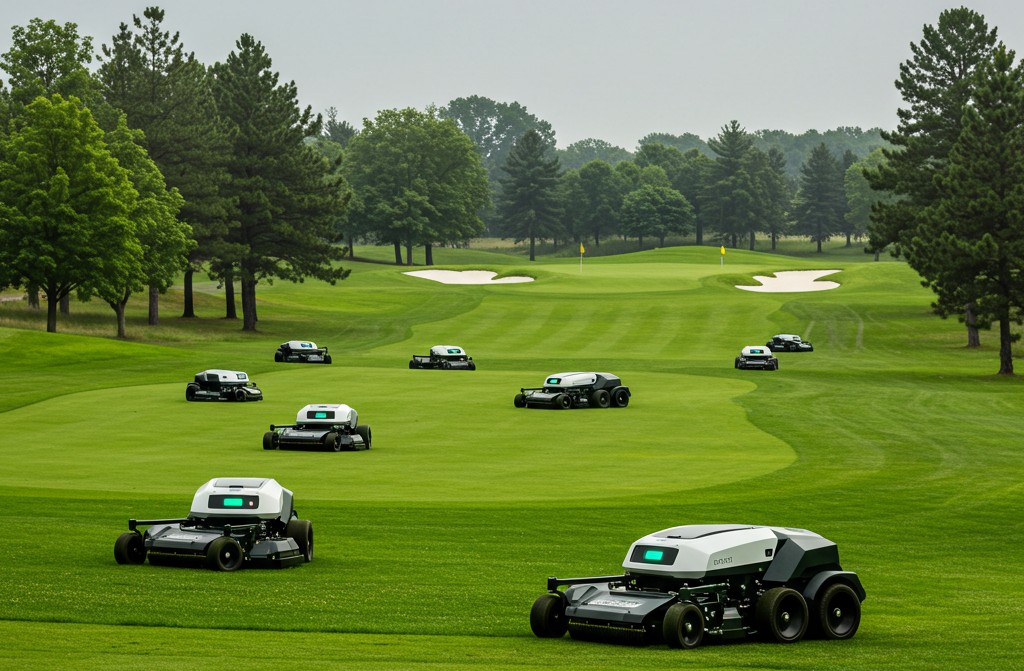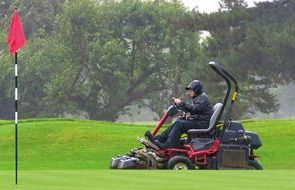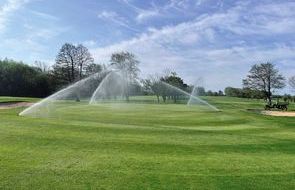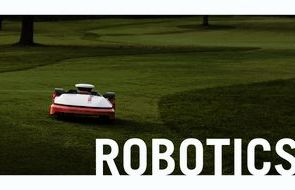- Homepage
- News and Features
- The rise of the mow-bots - is autonomy the future?
The rise of the mow-bots - is autonomy the future?
We asked three course managers from across the UK how robotic mowers and other areas of automation are impacting their course and the wider golf industry.
Meet the panel

Steve Lloyd
Course Manager

Neil McLoughlin
Course Manager, Deeside, Aberdeenshire

Sam Evans MG
Course Manager, North Hants, Hampshire

Greenkeepers are used to having their role diminished by those who regard them as little more than grass-cutters.
Well-informed golfers know better, but even they might wonder if the advent of autonomous mowers is easing the workload on greenkeeping teams. While it’s true that the sight of robots dutifully tending to playing surfaces is becoming an increasingly common one, does that really mean the human hands that once took care of them are now resting idle?
A trio of leading course managers explain why less mowing doesn’t necessarily mean less work.
How much has the role of technology grown in the time you have been in the industry?
Sam: Lots has changed about the role since I started around 17 years ago. These changes mean that we must critically evaluate almost every aspect of our role to be more efficient and meet ever-increasing expectations. Technology has really helped the industry, mainly by improving accuracy and the utilisation of time. It’s an area that is always evolving and it’s incredible to think what will be available in another 5-10 years.
Steve: You can see that evolution in something like irrigation systems. Where before you’d physically have to turn a valve to irrigate a green, now you have fully automated systems that can be managed from anywhere in the world. Other advances have allowed for more large-scale data collection, which as Sam suggested means we can be more accurate in understanding the conditions and the inputs required. Then of course there has been huge progress with autonomous equipment like mowers.
What advantages do greenkeepers gain from delegating a chunk of their grass-cutting duties to a robot?
Steve: There are definitely advantages in terms of timesaving and the ability to reallocate resources to other tasks. We have two guys cutting fairways, it’s a four-hour job, and we do that three times a week through the season on average. If that task were to be undertaken by autonomous mowers, that’s 24 hours per week that those two guys could be focussing on other tasks.
Neil: It’s the same for us. Using robotic mowers means we can spend more time edging and raking bunkers, we can spend more time weeding, we can spend more time hand-cutting greens rather than using triples – it just gives us more time to work on the details so we can improve the condition and look of the golf course.
Does using robotic mowers lead to improved playing conditions?
Neil: In our case they’ve definitely improved the quality of the golf course. For example, we’re using them on the rough and semi-rough, which would usually just get cut once or twice a week depending on how strong the growth rate is, but these machines are consistently cutting it three times a week, so it’s just better maintained. There are no grass clippings lying around either, so that’s another job it’s saving us.
Another example is the surround of the 1st green on our nine-hole course – it’s quite undulating, with some steep humps and hollows, but the automated machine we use has a cutting blade of around 12 inches and it can navigate the terrain. It has maintained that area to a higher standard than I’d seen before.
Steve: We trialled the CEORA on our 1st and 18th fairways for two months and it was bullet-straight and the quality of cut was fantastic. However, we’re a 1920s golf course and not much time was spent shaping our fairways, so there are a few imperfections. Over time we found because of our contouring and the width of the cutting tool, it scalped the surface a bit.
Also, it doesn’t present it the way a cylinder mower would – the stripe pattern is thinner, say three foot compared to the really well-defined 11-foot stripes you’d get with a cylinder mower with heavy rollers.
Have you encountered any other limitations?
Neil: We’ve got quite a dense tree population, meaning every so often a machine will get stuck after losing satellite signal, which leads to some downtime. They do need some looking after so it’s not like you can just send them out and forget about it, but on the whole we’ve had a really positive experience with them.
Are autonomous mowers less intrusive to the playing experience?
Steve: Mowing is the one area that’s the most disruptive to golfers in the daytime. We’re lucky in that we have two ride-on machines and can get out and do our fairways ahead of golf, but at a lot of smaller budget clubs, fairway mowing may well take a day or more and it can be during busy playing periods. At those clubs you might get around and cut tees, greens and approaches ahead of golf and not disrupt people, but you can’t get it all done.
There’s a beauty in being able to get all the fairways cut and then you can concentrate on the stuff you can do around the golf that won’t disturb anyone, because ultimately golfers don’t really want greenkeepers in front of them cutting the grass.
Neil: Our members find them fascinating – they’ll stand there and watch them. When a traditional rough mower goes over a golf ball with a rotary blade spinning, it’ll either slice it in two or send it flying 20-30 yards in a random direction, but with these machines it just bumps the ball out to the side. We had them out on our nine-hole course pretty much 24/7 last season and had no negative feedback at all really.
If greenkeepers aren’t cutting the grass any more, then what are they doing?
Steve: This is a common misunderstanding about the role of a greenkeeper and all the tasks the role involves. I have a WhatsApp group with 200 or so of the members where I post what we’re doing as a greenkeeping team and why we’re doing it. The members can’t comment, but they see it on a daily basis, and it’s amazing the number of people who came back after the first six months and said, ‘I had no idea that you guys have to do all these jobs’. It shows there can be quite a limited understanding of what we actually do.
Sam: Course set-up is of vital importance daily, and to have more staff and more time to fulfil this job is a luxury.
Many tasks are on the to-do list for a course manager, but resource and staff restrictions often mean these jobs do not get done. Removing some of the routine jobs, or making them more efficient through automation, means these other jobs on the list, which are often the noticeable ones to golfers, can get done and to a higher standard. This could be things such as edging sprinkler heads, working on weaker turf areas, cleaning golf course furniture and tidying areas on the course to create a more aesthetic appeal.
Do you worry that an increasing reliance on automation could threaten jobs?
Sam: I think automation can only enhance the golfing experience that we can offer. Any good greenkeeper should hopefully have nothing to worry about. There will always be a place for human intervention with our roles.
Steve: I don’t think anybody’s looking at it as a way to get rid of staff. Obviously, there are instances where clubs are short on staff, so they might see technology as a way to plug a gap, but primarily it gives you the ability to leave a more trivial job in the hands of technology and utilise your qualified staff to handle the skilled and technical side of things.
Neil: We’ve actually taken on a member of staff since we got the robots. There are obviously staffing challenges in the industry, but I think if a club is looking at buying robots to reduce numbers, then in my eyes that club isn’t being run properly.
If you could automate any task that forms part of your role, what would it be?
Sam: Having the ability to automate fairway mowing, the mowing of our practice facility and the clubhouse lawns would mean guaranteed quality and that staff resources could be allocated elsewhere. When we next look at a sprayer on our machinery replacement plan, I feel a GPS option would be a big benefit to ensure accuracy of application and consistent performance.
Neil: I’d happily let a robot take care of all the paperwork and allow me more time to be out on the golf course. To be honest, most people who come into this industry do it because they like being outside on the course doing the work that people can see the benefits of, not because they wanted to be sat in an office on the computer writing a report or keeping records.
Steve: Much like Neil, I’d love to just walk in and all my paperwork has been done, because that’s the real headache! But, for now, that’s still our job, and even on that front there are ways that technology can help. Out on the golf course, if I could get an autonomous solution that would deal with mowing fairways to the standard we require through the night so that I didn’t have the disruption for my members, and we walk in at six o’clock in the morning and it’s done, that would free up a huge amount of time in the season so that I could have my staff doing more detail work.
Could the growing role of technology attract people to greenkeeping?
Steve: Absolutely. I’ve got my two sons coming towards the end of their time at school, one of them wants to come into this industry and the other one’s very computer-savvy. They both came in and helped out during the summer holidays and even Ethan, who is not looking at being a greenkeeper, likes the technology side of stuff. There’s a different avenue there that didn’t exist before and we can really show people this isn’t just a manual job.
Sam: I think the growing role of technology will mean the greenkeeping industry will attract different people from different backgrounds. If we take the vehicle market into consideration, a vehicle mechanic used to need a screwdriver and spanner to make repairs, they now need a small computer to plug into a vehicle. I can see more people with computer backgrounds or technological knowledge being attracted to our industry in the same way.
How do you see technology impacting greenkeeping in the future?
Steve: I think the main thing it will do, in whatever form it takes, is allow us to make better educated decisions about course maintenance, and that will mean being more efficient. With tools that give us access to more data, we can be a lot more precise in when, where and how we target our efforts. There’s huge pressure on water resources, and golf clubs will need to demonstrate a high level of efficiency in how they’re using it. When you have the kind of data that new technology can provide, it makes that whole process a lot easier.
Neil: We should always be working smarter, not harder - and that’s where technology can make a difference. If we can come up with more efficient and effective ways to produce a better end product, then that makes sense to me. I won’t jump on every bandwagon that I see, but I’ll investigate it, do a demo and then you get to see the proof in the pudding, as we did with autonomous mowers. That’s one of those examples of working smarter, not harder.
Expert Insight
“Automation is supporting greenkeepers, not replacing them”
Andrew Lees, global segment manager at Husqvarna, says autonomous solutions free up greenkeepers to focus on the detail

If you have seen a fleet of grass-cutting robots out on your course, do not assume the greenkeeping team are sitting twiddling their thumbs – quite the opposite.
Husqvarna’s Andrew Lees insists the technology serves as a significant value-add when it comes to course maintenance.
“If you look at any golf club where they are short of staff or they only have a small team, it puts a lot of pressure on their resources,” said Lees. “With automation, it allows the machines to take care of the areas that would consume quite a lot of time for a member of staff to maintain.
“But this isn’t about replacing staff, rather freeing them up to focus on other tasks. The less time spent on those laborious areas means more time dedicated to taking care of the greens, bunkers and tees. Greenkeepers will tell you that it’s the ability to spend more time on those aspects that makes the biggest difference to being able to produce the best course conditions, and therefore the best playing experience.”
For example, at this time, the greens remain beyond the capabilities of automated machines, which, in the case of Husqvarna’s products, can cut down to 10 millimetres. The grass on putting surfaces is generally less than half that length.
Where automation could take us next…
Here are six tasks that could become fully automated, according to Maya Global Founder and CEO Valentine Godin

1) Irrigation management
With increasing pressure on golf clubs to use water efficiently, smart irrigation systems can provide the solution, utilising weather data and soil moisture levels to tailor watering schedules to maximise efficiency and reduce waste.
2) Bunker raking
Similar to robotic mowers but with a rake attachment rather than a cutting blade, these handy little machines do exist but aren’t yet in common use.
3) Leaf gathering
Not every golf course has trees, but for the many that do – and have them in abundance – the process of clearing leaves is a time-consuming task. A robot tailored to leaf collection or leaf blowing would alleviate greenkeepers of a much-maligned task.
4) Turf repair
Autonomous machines could perform minor turf repairs, such as filling divots or smoothing out areas with damaged turf.
5) Pest and weed control
Drones or autonomous vehicles equipped with sensors could patrol the course to detect pests or weed growth. Targeted application of pesticides or herbicides could be done more efficiently and precisely, reducing the need for large-scale spraying.
6) Ball retrieval
Automated systems or robots could be used to retrieve lost golf balls from hard-to-reach spots (like water hazards) or as part of a ball cleaning operation, potentially even bringing the balls back to the clubhouse for reuse.
…but nature’s lawnmowers may also have a role to play
Berkhamsted Golf Club in Hertfordshire club is fully embracing its long history of cattle grazing on the common where the course is laid out.

Despite the inexorable rise of technology, some age-old methods of maintaining the land have stood the test of time. Cows are nature's lawnmowers, happy to graze for up to eight hours a day, and one golf club in Hertfordshire has found a way to turn its herd of Devon reds into a high-tech team of grass-munching machines.
Up until World War II, cattle grazing on Berkhamsted Common were a regular sight, but they didn't return after the war and it wasn't until 2023 that Berkhamsted Golf Club brought them back. Each of the herd wears a special GPS collar, enabling the club to control where they graze, so golfers should not encounter any bovine bother.
"As custodians of the common we have obligations which cover the entire ecosystem and not just the golf course – which covers less than a third of the whole area," said the club. "We have received fantastic advice from the experts, and the cattle will help Berkhamsted residents and visitors to continue to enjoy using the common for generations to come."
The initiative is part of a regenerative farming project which the golf club, as custodians of the 520-acre Berkhamsted Common estate, has developed with the assistance of Chilterns National Landscape, and the Herts & Middlesex Wildlife Trust. "This is a great example of how modern technology can be married with traditional farming commonsense, to produce a wonderful situation for the whole Berkhamsted community to enjoy. Berkhamsted Common is one of the finest pieces of land in England, and our new herd of Devon Reds are already adding their own special beauty to the area," the club added.
What to read next
Author






